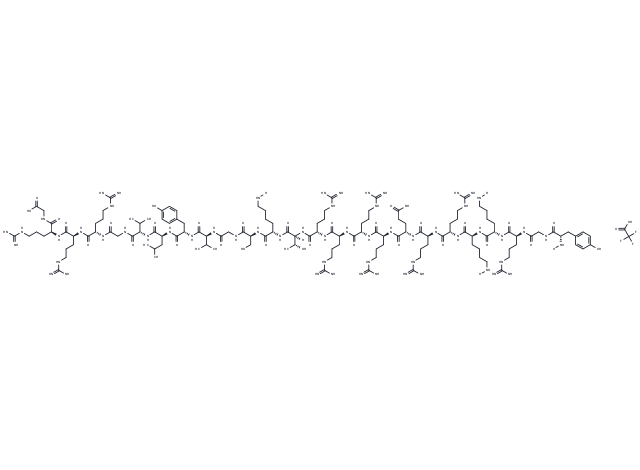Shopping Cart
- Remove All
 Your shopping cart is currently empty
Your shopping cart is currently empty

Tat-βsyn-degron, an α-synuclein knockdown peptide, integrates three domains: the HIV-1 Tat plasma membrane transduction domain, an α-synuclein binding domain (βsyn) representing amino acids 36-45 of β-synuclein, and a proteasomal targeting domain (degron). It effectively binds to recombinant α-synuclein, demonstrating a significant reduction in α-synuclein levels in primary rat cortical neuron cultures.

| Pack Size | Price | Availability | Quantity |
|---|---|---|---|
| 1 mg | $63 | Backorder | |
| 5 mg | $296 | Backorder | |
| 10 mg | $561 | Backorder | |
| 25 mg | $1,240 | Backorder |
| Description | Tat-βsyn-degron, an α-synuclein knockdown peptide, integrates three domains: the HIV-1 Tat plasma membrane transduction domain, an α-synuclein binding domain (βsyn) representing amino acids 36-45 of β-synuclein, and a proteasomal targeting domain (degron). It effectively binds to recombinant α-synuclein, demonstrating a significant reduction in α-synuclein levels in primary rat cortical neuron cultures. |
| In vivo | Administrating Tat-βsyn-degron at 40 mg/kg reduces α-synuclein levels in the brains of M38 transgenic mice overexpressing human A53T mutant α-synuclein. It also diminishes phosphorylated α-synuclein levels in the substantia nigra and the pons, alongside neuroinflammation in mice exposed to α-synuclein preformed fibrils, simulating spreading synucleinopathy. Furthermore, at a dosage of 6 µmol/kg intraperitoneally, Tat-βsyn-degron ameliorates dopaminergic neuron loss and improves motor deficits in mice suffering from MPTP-induced Parkinson’s disease, underscoring its potential therapeutic benefit. |
| Molecular Weight | 3146.67 |
| Formula | C132H237N59O31.XCF3COOH |
| Storage | keep away from moisture | Powder: -20°C for 3 years | In solvent: -80°C for 1 year | Shipping with blue ice. |
| Solubility Information | DMF: 50 mg/mL (15.89 mM), Sonication is recommended. PBS pH 7.2: 1 mg/mL (0.32 mM), Sonication is recommended. |

Copyright © 2015-2025 TargetMol Chemicals Inc. All Rights Reserved.